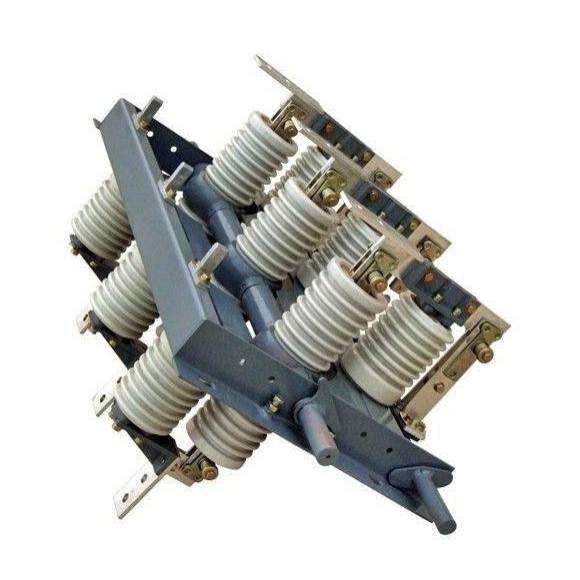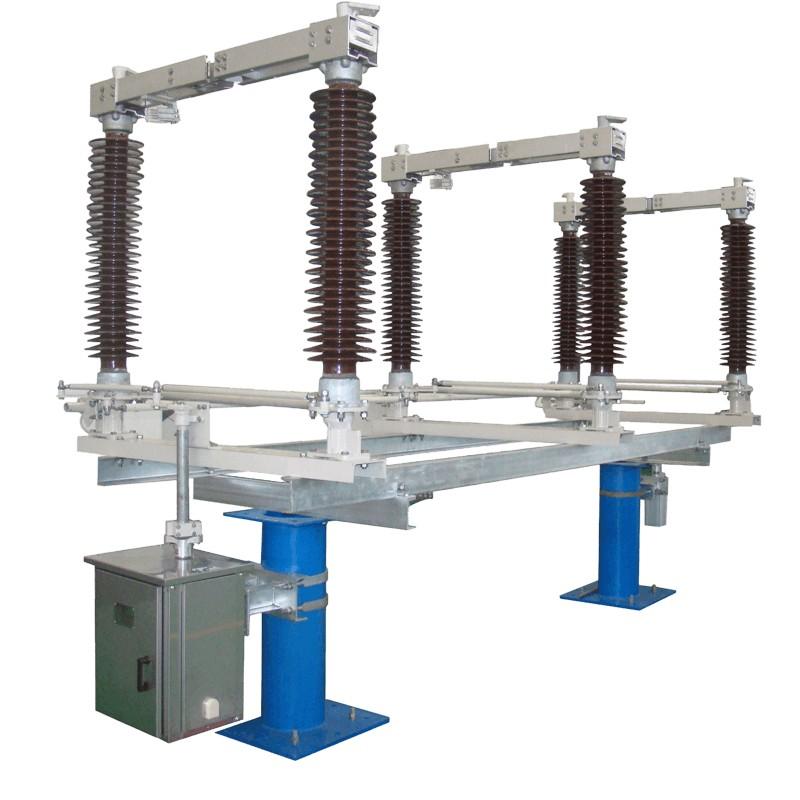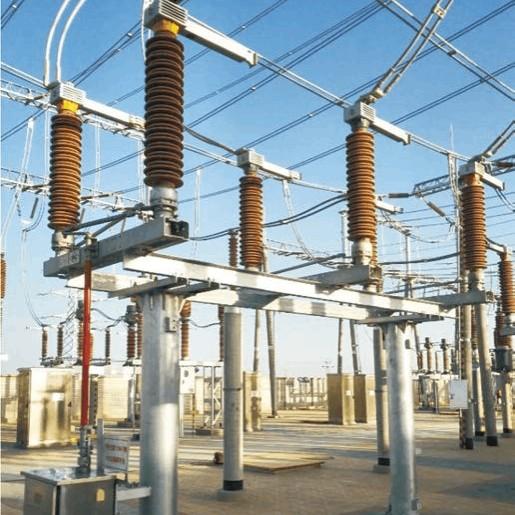1.Paghulagway sa Panganak nga Ginapadala
Ang pagkamalas kontra sa 550 kV GIS nga equipment nangyari sa 13:25 sa Agosto 15, 2024, samtang ang equipment nagoperasyon sa full load ngadto sa 2500 A nga load current. Sa oras sa pagkapadala, ang mga associated protection devices nagsilbi agad, tripping ang corresponding circuit breaker ug isolating ang faulty line. Ang operating parameters sa system mubo uban sa significant changes: ang line current nagdrop gawas gawas gikan sa 2500 A hangtod sa 0 A, ug ang bus voltage nagdrop gawas gawas gikan sa 550 kV hangtod sa 530 kV, nag-fluctuate gamay sa tibuok 3 segundos bago nag-recover gradual hangtod sa 548 kV ug estabilisar. Ang inspection sa site sa maintenance personnel nakita ang obvious damage sa disconnector. Nakit-an ang burn mark nga may 5 cm ka haba sa surface sa insulating bushing. Naka-appear usab ang discharge scorch spot nga may 3 cm ka diameter sa connection sa moving ug fixed contacts, surrounded sa black powdery residue, ug ang pipila ka metal components nagpakita og signs sa melting, na nagpakita og intense arcing sa panahon sa fault.
2.Analysis sa Cause sa Fault
2.1 Analysis sa Basic Equipment Parameters ug Operating Conditions
Ang disconnector adunay rated voltage nga 550 kV, rated current nga 3150 A, ug breaking current nga 50 kA. Kini nga mga parameter naghimong komportable sa operational requirements sa 550 kV system sa substation, teoretikal nga nag-ensure og reliable operation sa normal conditions. Ang disconnector nagserbisyo na sa 8 tuig ug 350 operations. Ang pinakabag-o nga maintenance gibutang sa Hunyo 2023, kasama ang contact polishing, lubrication, mechanism adjustment, ug insulation resistance testing—tanang resulta naghimong compliant sa specifications sa panahon. Bisag ang numero sa operations adunay normal range, ang long-term operation mahimong magpadayon sa aging risks, posibleng mogresulta sa latent defects sa susunod nga serbisyo.
2.2 Electrical Performance Test Analysis
Ang insulation resistance testing sa disconnector naghimo og inter-contact insulation resistance nga 1500 MΩ (historical value: 2500 MΩ; standard requirement: ≥2000 MΩ). Ang ground insulation resistance 2000 MΩ (historical value: 3000 MΩ; standard requirement: ≥2500 MΩ). Tanang values significantly lower sa historical data ug standards, nagpakita og degraded insulation performance.
Ang dielectric loss factor (tanδ) testing sa 10 kV nagresulta sa measured value nga 0.8% (historical value: 0.5%; standard requirement: ≤0.6%). Ang taas na tanδ nagpakita og possible moisture ingress o aging sa insulation medium, nga mubaba sa insulation strength ug mobuto sa risk sa dielectric breakdown.
2.3 Mechanical Performance Test Analysis
Ang contact pressure measurements naghimo:
Phase A: 150 N (design value: 200 N, deviation: –25%)
Phase B: 160 N (deviation: –20%)
Phase C: 140 N (deviation: –30%)
Tanan measured contact pressures below design values ug large deviations, probable cause sa increased contact resistance, localized overheating, ug arcing.
Ang operational mechanism analysis naghimo:
Closing time: 80 ms (design range: 60–70 ms); synchronism deviation: 10 ms (design limit: ≤5 ms)
Opening time: 75 ms (design range: 55–65 ms); synchronism deviation: 12 ms (design limit: ≤5 ms)
Tanan opening/closing times exceeded design limits, ug synchronism deviations excessive, nagpakita og mechanism malfunction nga probable cause sa asynchronous contact/separation, leading sa arc reignition ug discharge.
2.4 Comprehensive Fault Cause Analysis
Integrating all findings:
Electrically, reduced insulation resistance ug increased tanδ nagpakita og deteriorated insulation, creating conditions for breakdown.
Mechanically, insufficient contact pressure nagpakita og poor contact ug localized heating, while abnormal mechanism performance led to asynchronous operation ug arc reignition, exacerbating insulation damage.
Bisag regularly maintained, ang long-term service exposed the equipment to aging, ug environmental factors such as temperature ug humidity fluctuations further degraded performance. Ang flashover fault sa disconnector resulta sa combined effects sa insulation degradation, mechanical anomalies, ug equipment aging.
3.Fault Handling Measures
3.1 On-Site Emergency Response
Immediately after the flashover fault, an emergency response protocol was activated to ensure grid safety. The faulty disconnector was isolated by tripping associated circuit breakers, preventing fault escalation. Protection devices linked to the disconnector were inspected and adjusted to avoid maloperation or failure. System operation mode was urgently reconfigured: load previously carried by the faulty line was smoothly transferred to healthy lines to maintain power supply to critical users. During this process, system parameters (voltage, current, frequency) were closely monitored to ensure stable operation. Personnel were assigned to secure the fault site and prevent unauthorized access, avoiding secondary incidents.
3.2 Equipment Repair Plan
Based on root cause analysis, a detailed repair plan was developed:
For degraded insulation: replace and restore insulation media. Remove damaged, moist, or aged insulation materials and install new, compliant materials to restore insulation performance.
For insufficient contact pressure: inspect and replace contact springs, adjust contact pressure to design values to minimize contact resistance and prevent overheating/arcing.
For mechanism faults: replace damaged components and fully recalibrate the mechanism to meet design specifications for timing and synchronism.
3.3 Proseso sa Pagpangataas ug mga Punto nga Teknikal
Ang pagpangataas gisunod ang plano. Ang disconnector gipuno nga gibuwag aron mapailubon ang pag-inspeksyon para mokonfirmar ang kasinatian sa pinsala. Sa panahon sa pagbag-o sa insulasyon, gikontrol ang humidity ug temperatura sa palibot aron malihok ang kontaminasyon o pag-absorbo sa bag-ong materyales. Ang pag-install sigurado nga naka-posisyon ug maayo nga giputli ang insulasyon aron malihok ang mga butasan o pagkawasak. Ang pag-adjust sa presyon sa contact gigamit og mga kalibradong kagamitan aron makab-ot ang eksakto ug uniform nga pwersa sa tanang fasa. Ang pagbutangi balik ug pagkalibrar sa mekanismo gisunod sa prosedura aron masiguro ang maayo ug reliable nga operasyon. Human sa pagpangataas, gihimo ang komprehensibo nga mga test—insulation resistance, tanδ, contact pressure, ug performance sa mekanismo—tanang nakakadugay sa standard bago igbalik ang energiya.
4.Pagpakita sa Epektividad sa Pagpangataas
4.1 Pag-test Pasud-an sa Pagpangataas
Komprehensibo nga mga test nagpakita sa ginrestored nga performance (tanan ang makita sa Table 1):
Insulation resistance: ang inter-contact naaasenso gikan sa 1500 MΩ hangtod sa 2400 MΩ; ang ground resistance naaasenso gikan sa 2000 MΩ hangtod sa 2800 MΩ—tanan nakakadugay sa standard.
Tanδ nabag-o gikan sa 0.8% hangtod sa 0.4%, sa acceptable nga limites, nagpakita sa resolution sa moisture/aging issues.
Withstand voltage test: pre-repair breakdown nahitabo sa 480 kV (< standard); post-repair, walay breakdown sa 600 kV—validating insulation recovery.
| Pamaong Pamaagi |
Datu Bago Ang Pagpuno |
Datu Human Sa Pagpuno |
Standard Value |
Qualified or Not |
| Insulation Resistance (MΩ) |
Gikan sa paggalaw ug statikong kontakto: 1500Sa ground insulation: 2000 |
Gikan sa paggalaw ug statikong kontakto: 2400Sa ground insulation: 2800 |
Gikan sa paggalaw ug statikong kontakto: ≥2000Sa ground insulation: ≥2500 |
Oo |
| Dielectric Loss Tangent tanδ (%) |
0.8 |
0.4
|
≤0.6 |
Oo |
| Withstand Voltage Test (kV) |
Nagkaroon ng breakdown sa tinukoy na test voltage, ang breakdown voltage ay 480kV |
Walang nangyaring breakdown sa tinukoy na test voltage na 600kV |
≥600kV |
Oo |
4.2 Paghimo ug Pagsusi sa Operasyon
Ang nirepair nga disconnector gipangita-as 3 ka bulan sa operasyonal nga pag-monitor. Ang temperatura sa mga contact adunay normal, nagpatibay kini nga ang adjustment sa presyon sa contact ug ang kontrol sa resistance sa contact maayo. Ang switching operations naging stable: ang closing time mao ang 65 ms, ang opening mao ang 58 ms, ug ang synchronism deviations ≤3 ms. Walay arc reignition o discharge nga nangyari. Ang kombinado nga resulta sa test ug monitoring nagpatibay sa maayong resolution sa fault ug stable nga operasyon.
5.Pagpanalipod ug Mga Rekomendasyon
Arangkada matino nga strategy sa pag-uli aron masiguro ang efficient nga operasyon sa GIS ug pabawason ang risk sa fault:
Regular nga inspeksyon: Isugyot ang weekly nga visual checks ug monthly nga functional tests pinaagi sa qualified nga teams aron masayri ang damage o anomalies sa dili pa madaghan.
Advanced nga condition monitoring: I-deploy ang online monitoring systems alang sa real-time tracking sa partial discharge, temperatura, ug gas composition aron masayri ang potential nga issues proactively.
Preventive testing: Ipahimulos ang periodic nga insulation resistance ug tanδ tests aron i-assess ang electrical/insulation health ug pangutana ang aging o moisture-related failures.
Pagpili ug pag-install sa equipment: Pilili ang proven, mature GIS equipment nga naghulagway sa operational needs. Sumala matino sa design ug construction standards samtang nag-install aron masiguro ang proper alignment ug secure connections.
Commissioning: Rigorously verify all performance parameters during commissioning, documenting all data for future maintenance reference.
Training sa personnel: Regular nga isugyot ang technical training ug emergency drills aron mapataas ang proficiency sa staff sa operasyon ug pag-handle sa fault, masiguro ang rapid, effective responses sa incidents ug protection sa grid stability.
6.Konklusyon
Kini nga paper nagpresentar og successful nga analysis ug resolution sa flashover fault sa 550 kV GIS disconnector. Ang detailed nga documentation sa fault ug multi-dimensional testing accurately identified root causes. Ang gi-implement nga emergency response ug repair measures effectively resolved the issue, validated by post-repair tests ug operational monitoring. Ang proposed nga preventive measures targeted ug practical, offering valuable guidance for GIS maintenance. Future work should deepen research into GIS fault mechanisms to further enhance power system security and reliability.






















